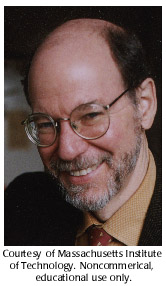Concept 38 Development balances cell growth and death.



 Lee Hartwell was one of the first to use yeast as a model system, and he identified many of the genes involved in the cell cycle. Bob Horvitz and Mike Hengartner used C. elegans to work out the mechanism of programmed cell death. Scott Lowe's research has shown how the regulation of the cell cycle affect cancer.
Lee Hartwell was one of the first to use yeast as a model system, and he identified many of the genes involved in the cell cycle. Bob Horvitz and Mike Hengartner used C. elegans to work out the mechanism of programmed cell death. Scott Lowe's research has shown how the regulation of the cell cycle affect cancer.
Howard Robert Horvitz (1947-)

Bob Horvitz was born in Chicago, Illinois. His mother was a teacher and his father was an accountant. Both parents instilled in Horvitz a respect and passion for learning. As a child, Horvitz maintained a butterfly collection, and thought that biology involved collecting and classifying dead things. He was a good student and interested in many subjects including English and journalism. He received two undergraduate degrees from the Massachusetts Institute of Technology, one in Mathematics and one in Economics. He considered going into law, medicine, business and even computer science. But because he didn't know anything about, and was intrigued by molecular biology (Horvitz didn't take any biology courses until his senior year in university) he entered graduate school at Harvard University to study biology.
Horvitz was interested in neurobiology, but because of his limited experience with biology in general, he started working with phage, to learn the basics. Horvitz was a graduate student in the laboratories of James Watson and Walter Gilbert, an experience he found "interesting." After his doctorate in 1974, Horvitz went to the Medical Research Council in Cambridge to work with Sydney Brenner.
Brenner was advocating a new model system for studying development. Caenorhabitis elegans is a non-parasitic roundworm that is amenable to genetic analysis, and is easy to grow and maintain. Horvitz saw the advantages of C. elegans, and used it to study a number of developmental systems including neuronal development, the ras pathway and the genetics of cell lineage. Programmed cell death is only one of the many ongoing projects in his lab.
In 1978, Horvitz accepted a position in the Department of Biology at the Massachusetts Institute of Technology. He is now Whitehead Professor of Biology. He has been an Howard Hughes Medical Institute investigator since 1988, and has won a number of awards for his work including the 1999 Gairdner Foundation Award. Horvitz has been a member of the National Academy of Science since 1991 and serves on a number of editorial boards and advisory committees, both governmental and commercial. He has a number of patents pending based on work done in his lab.
Horvitz enjoys reading in his spare time, particularly British contemporary novels.
Horvitz shared the 2002 Nobel Prize in Physiology or Medicine with colleagues John Sulston and Sdyney Brenner. All three made major contributions in the field of developmental biology using the model organism Caenorhabditis elegans.


The cells that don't undergo programmed cell death in C. elegans often share the same cell fate as their sisters. The extra cells don't seem to have any detrimental effects.

The "extra" cells in C. elegans mutants that don't undergo programmed cell death are often nerve cells. Are these worms smarter?
 DNA is packaged in a chromosome.
DNA is packaged in a chromosome. Higher cells incorporate an ancient chromosome.
Higher cells incorporate an ancient chromosome. Some DNA does not encode protein.
Some DNA does not encode protein. Some DNA can jump.
Some DNA can jump. Genes can be turned on and off.
Genes can be turned on and off. Genes can be moved between species.
Genes can be moved between species. DNA responds to signals from outside the cell.
DNA responds to signals from outside the cell. Different genes are active in different kinds of cells.
Different genes are active in different kinds of cells. Master genes control basic body plans.
Master genes control basic body plans. Development balances cell growth and death.
Development balances cell growth and death. A genome is an entire set of genes.
A genome is an entire set of genes. Living things share common genes.
Living things share common genes. DNA is only the beginning for understanding the human genome.
DNA is only the beginning for understanding the human genome.